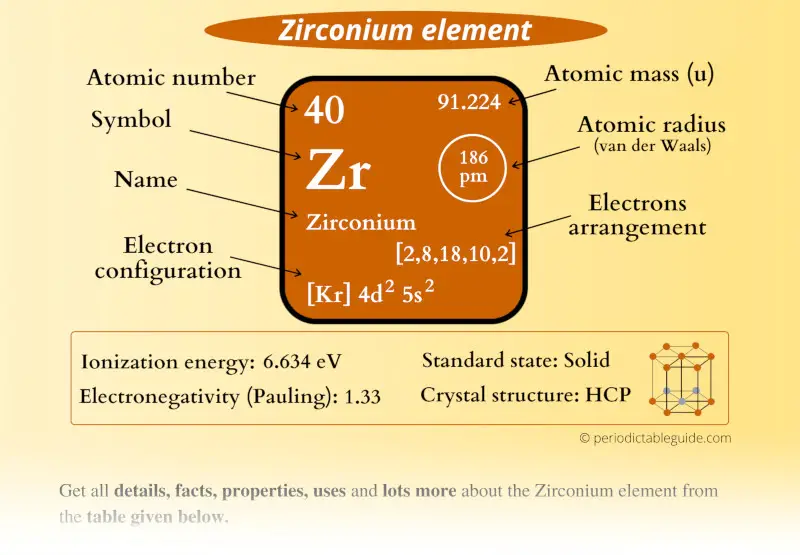
This is a SUPER easy guide on Zirconium element.
In fact, the table mentioned below is the perfect information box (Which gives you every single detail about the Zirconium element in Periodic table.)
So if you want to know anything about Zirconium element, then this guide is for you.
Let’s finish this very quickly.
Zirconium Element (Zr) Information
| Appearance | 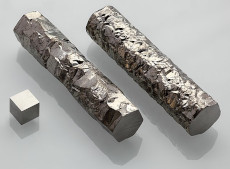 Silvery white |
| State (at STP) | Solid |
| Position in Periodic table | 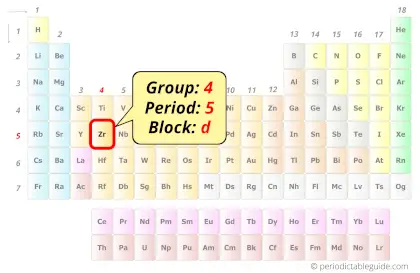 Group: 4, Period: 5, Block: d |
| Category | 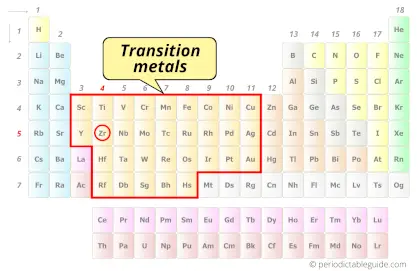 Transition metals |
| Atomic number or Protons | 40 |
| Neutrons | 51 |
| Electrons | 40 |
| Symbol | Zr |
| Atomic mass | 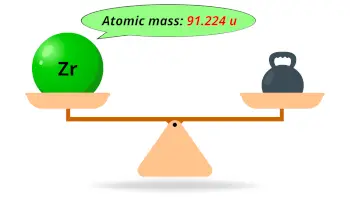 91.224 u |
| Electrons arrangement or Bohr model | 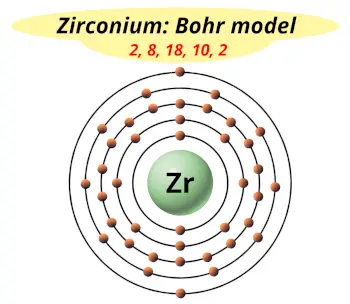 2, 8, 18, 10, 2 |
| Electronic configuration | [Kr] 4d2 5s2 |
| Atomic radius | 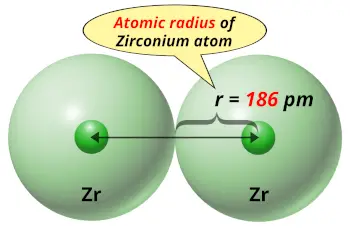 186 picometers (van der Waals radius) |
| 1st Ionization energy | 6.634 eV |
| Electronegativity | 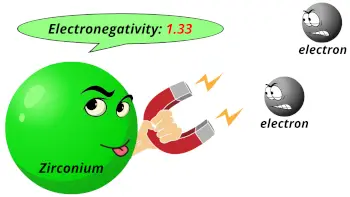 1.33 (Pauling scale) |
| Crystal structure | 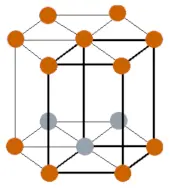 HCP (Hexagonal close packing) |
| Melting point | 2128 K or 1855 °C or 3371 °F |
| Boiling point | 4650 K or 4377 °C or 7911 °F |
| Density | 6.511 g/cm3 |
| Main isotope | 90Zr |
| Who discovered Zirconium and when? | 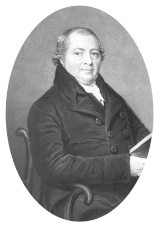 Martin Heinrich Klaproth in 1789 |
| CAS number | 7440-67-7 |
Zirconium in Periodic table
Zirconium element is in group 4 and period 5 of the Periodic table. Zirconium is the d-block element and it belongs to Transition metals group.
| H | He | ||||||||||||||||
| Li | Be | B | C | N | O | F | Ne | ||||||||||
| Na | Mg | Al | Si | P | S | Cl | Ar | ||||||||||
| K | Ca | Sc | Ti | V | Cr | Mn | Fe | Co | Ni | Cu | Zn | Ga | Ge | As | Se | Br | Kr |
| Rb | Sr | Y | Zr | Nb | Mo | Tc | Ru | Rh | Pd | Ag | Cd | In | Sn | Sb | Te | I | Xe |
| Cs | Ba | La* | Hf | Ta | W | Re | Os | Ir | Pt | Au | Hg | Tl | Pb | Bi | Po | At | Rn |
| Fr | Ra | Ac** | Rf | Db | Sg | Bh | Hs | Mt | Ds | Rg | Cn | Nh | Fl | Mc | Lv | Ts | Og |
| *Ce | Pr | Nd | Pm | Sm | Eu | Gd | Tb | Dy | Ho | Er | Tm | Yb | Lu | ||||
| **Th | Pa | U | Np | Pu | Am | Cm | Bk | Cf | Es | Fm | Md | No | Lr |
←Move to: Yttrium (Y) element – Periodic Table
→Move to: Niobium (Nb) element – Periodic Table
Why is Zirconium in Period 5?
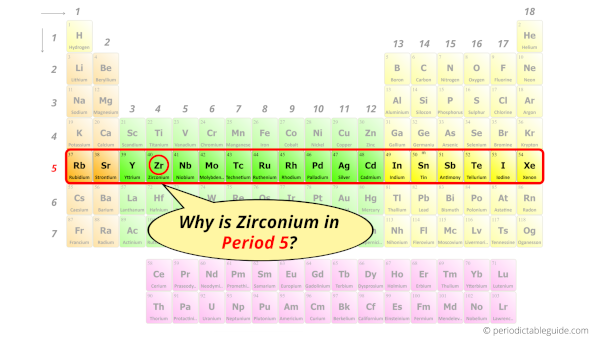
Let me ask you a question.
How many shells does Zirconium have?
It’s 4. Right?
You have already seen the bohr model of zirconium atom in the above table.
From the Bohr model, it can be found that the number of orbits or shells in zirconium is 5. Hence, as zirconium has 5 orbits, it lies in period 5 of the Periodic table.
Why is Zirconium in d-block?
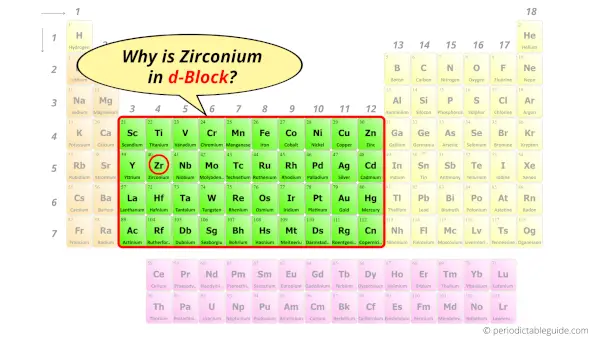
Before knowing this reason, first of all I want to ask you a simple question.
How can you determine the blocks-wise position of elements?
The simple answer: The elements will lie in the s, p, d or f block will completely depend upon the subshell in which the last electron will enter.
For example; the electron configuration of zirconium is [Kr] 5s2 4d2.
So the last electron of zirconium enters the d-subshell or d-orbital.
Hence, zirconium is the d-block element.
Is Zirconium a Transition Metal? Why?
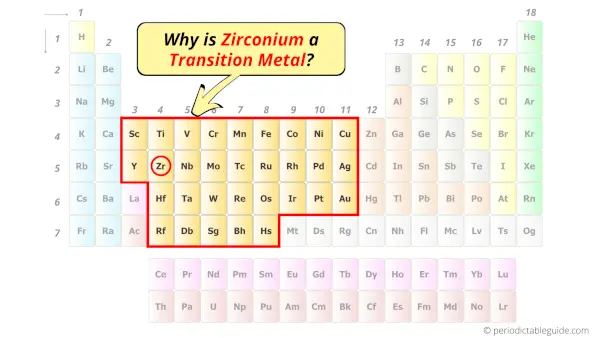
Yes, Zirconium is a transition metal because it has incompletely filled d-orbital in its ground state.
Let me explain the exact meaning of this.
According to the definition of transition metals;
The element should compulsorily have incomplete d-orbitals, either in their ground state (M) or most common oxidation states (M1+, M2+, etc) then only they are called transition metals.
Now, the ground state of Zirconium means its normal state in which it has neither gained nor lost any electron/s.
So the ground state of Zirconium is Zr.
And the ground state electronic configuration of Zirconium is [Kr] 5s2 4d2.
In this state, if we see the electron configuration of Zirconium, then it possesses incomplete d-orbitals.
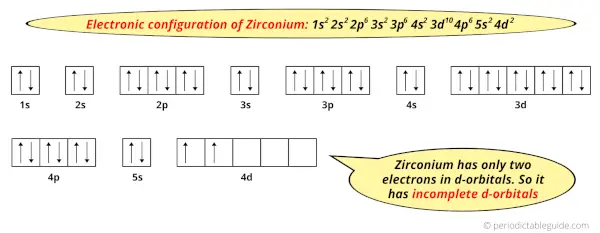
Because, there are only two electrons in the d-orbitals.
In order to have the complete d-orbitals, there must be 10 electrons in it.
But in the ground state electronic configuration of zirconium, you can see that it has only 2 electrons in d-orbitals.
Thus, Zirconium has incomplete d-orbitals.
And hence, as Zirconium has incomplete d-orbitals, it is considered as a transition metal.
8 Interesting facts about Zirconium
Interesting facts about zirconium element are mentioned below.
- The name zirconium was derived from the Persian word “Zargun” (meaning gold color).
- The abundance of zirconium in earth’s crust is around 165 ppm (parts per million) by weight.
- In ancient ages, zirconium was used in decorative items as well as in jewelry.
- Martin Heinrich Klaproth was a German chemist who discovered zirconium in 1789 from Berlin (the sample of zirconium silicate was from Sri Lanka).
- In the entire world, the total amount of zirconium production is around 7000 tons per year.
- Australia and South Africa are the places from where most of the zirconium is obtained.
- Around 58% of the world’s total zirconium production is done in Australia.
- Zirconium is also present in the Sun as well as meteorites.
Properties of Zirconium
The physical and chemical properties of zirconium element are mentioned below.
Physical properties of Zirconium
Physical properties of zirconium are mentioned below.
- Zirconium is a transition metal having a Silvery white appearance.
- Zirconium is a malleable and ductile metal. Hence it can be drawn into sheets and wires.
- The melting point of zirconium is 1855 °C and its boiling point is 4377 °C.
- The atomic mass of zirconium is 91.224 u and its density is 6.511 g/cm3.
- Zirconium has natural as well as synthetic isotopes, but out of them the most abundant stable isotope is 90Zr (its abundance is 51%).
Chemical properties of Zirconium
Chemical properties of zirconium are mentioned below.
- Zirconium has incomplete d-orbitals and hence it is classified as a transition metal on the periodic table.
- The powdered form of zirconium is flammable.
- Zirconium metal is resistant to corrosion. Hence it is used in manufacturing the components like surgical appliances, lamp filaments, etc.
Uses of Zirconium
Uses of zirconium are mentioned below.
- Zirconium is used as an alloying metal in manufacturing of metals like steel.
- There is current research going on regarding zirconium metal that may help in fighting cancer in near future.
- Zirconium looks similar to that of diamond, hence it has been used as a gemstone.
- Zircaloy is an alloy that contains zirconium metal, has various nuclear applications (like cladding of nuclear fuel, etc.)
- Zirconia (an oxide containing zirconium) is used in crucibles that helps it to withstand higher temperatures.
- Zirconium is also found in the human body that is obtained from foods like wheat, eggs, brown rice, spinach, etc. but zirconium has no biological functions.
Explore our New Interactive Periodic Table (with Rotating Bohr Models and More)

Details about this Periodic table:
- Access detailed info on all elements: atomic mass, electron configurations, charges, and more.
- View rotating Bohr models for all 118 elements.
- Get a free HD image of the Periodic Table.
Note: For future use, bookmark this Periodic table or visit “PeriodicTableGuide.com”
External resources:
- Zirconium – Element information, properties and uses | Periodic Table. (n.d.). Zirconium – Element Information, Properties and Uses | Periodic Table. https://www.rsc.org/periodic-table/element/40/zirconium
- Zirconium – Wikipedia. (2007, December 10). Zirconium – Wikipedia. https://en.wikipedia.org/wiki/Zirconium
- P. (n.d.). Zirconium | Zr (Element) – PubChem. Zirconium | Zr (Element) – PubChem. https://pubchem.ncbi.nlm.nih.gov/element/Zirconium
- It’s Elemental – The Element Zirconium. (n.d.). It’s Elemental – the Element Zirconium. https://education.jlab.org/itselemental/ele040.html
